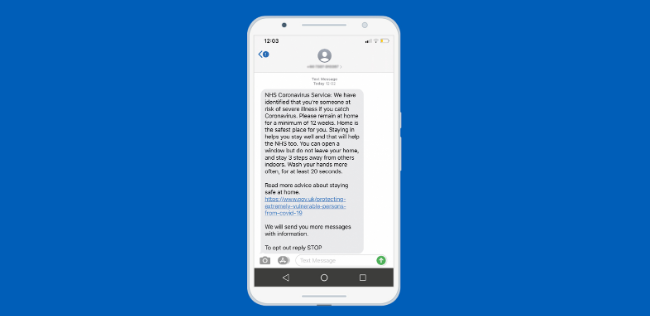Almost 2 million people in England have received daily SMS texts from the NHS warning them of the risks of coronavirus. Recipients of these messages have included: people who stand the highest risk of complications should they catch Covid-19 e.g. those who have significant respiratory conditions; and anyone who identifies as having symptoms via NHS 111 online. People living with underlying conditions received messages supporting them to isolate for 12 weeks. People who develop the symptoms of coronavirus have the option to receive 7-14 days of text messages to help them through that particularly challenging period alone or as a household.
These different groups have received customised text messages informed by behavioural science with advice on what they and members of their household need to do to stay safe. Here we share the behavioural principles and approach that we used to help our partners at NHSX, NHS Digital and the NHS Business Services Authority to design these messages.
Understand the demand to set the appropriate default
When preparing to communicate with people it was vital to put ourselves into the shoes of the recipients. We started by checking whether people even wanted to receive advice directly to their phones. In a Predictiv survey of over 600 people we found that over 85% were keen to receive texts from the NHS, and 60% were happy to get messages at least once every other day. To account for the minority who did not support this channel of communication, an opt-out was included in every message.
Prioritise key points
Disseminating guidance via text message forces you to stick to the essentials and keep instructions simple. Our challenge was to distill the official guidance on shielding vulnerable people (itself 3425 words long) into a daily succinct text message. At a time of overwhelming change for most, we considered it key to ensure information was carefully prioritised and sent over a 7 day period, allowing people to digest each instruction. Since recalling complex information can be more difficult during times when resources and attention is stretched thinly, it was important for us to focus on communicating the most important information first. As such we led with the guidance that people needed to remain physically distant from others for a minimum of 12 weeks. This instruction was sent to people on Day 1 to denote their importance. Tips about other aspects of life, e.g. about how to maintain social contact (from a distance), were then sent on later days e.g. Days 2 and 5.
Make novel instructions as familiar as possible
We made descriptions of this new behaviour of shielding as relatable as possible in order to minimise the confusion that was spreading faster than the virus itself. Some receiving this message live in inner city tower blocks and others in rural fringes with large gardens. Therefore we rationalized that everyone would be able to open a window for fresh air, but not all would be able to step outside their properties. Similarly, we know that taking up new routines needs more than a one-off text message in order to stick. Hence we suggested putting signs up on doors to remind people how to use their space.

Draw on new and existing insights
We drew on emerging research to ensure the content itself would meet emerging needs. For example, we were sure to provide information about why this population was being asked to stay at home for 12 weeks. Recent studies into the psychological impact of quarantine show that providing a clear rationale for isolation measures can protect mental health and well being.
We know from trials on student exams attainment that social commitment and accountability play a big part in influencing behaviour. We leveraged these techniques to encourage people to stay at home. The text messages asked recipients to establish a social commitment by letting friends or family know that they are following 111 advice to stay at home.
If you live alone, text a friend or a family member to let them know you are following advice to stay at home until it is safer to mix with others. Plan to chat to someone over the phone at least once a day.
Furthermore, drawing on research that suggests that planning and “chunking” time, can ease anxiety during stressful periods and health emergencies, we added this advice:
“Try to stick as closely as you can to your typical daily routine.”
“Are there things you enjoy doing at home that you usually don’t have time for?”
“Congratulate yourself and others in your home for reaching the halfway point.”
Finally, the SMS texts sought to help people through the final days of their isolation period by emphasising the altruistic nature of self-isolating. The final days of isolation may be the hardest as most people are expected to be feeling better after day 6 of symptoms, yet they remain contagious for at least a further 24 hours.
These last 4 days are as important as the first to protect your friends, family and neighbours and in supporting the NHS, so please do not leave your home… What you are doing is really important and the NHS is grateful.
Iterate as you go
Once it became available, we quickly analysed feedback received in response to the first batch of messages. We used sentiment analysis – a technique that allows us to interpret and classify emotions within text data as positive, negative or neutral – to analyse responses. Twice as many of the responses from those in the vulnerable group expressed positive sentiments and a ‘thank you’ as negative ones or concerns. A similar proportion to sent questions needing more information about how to access services remotely whilst in isolation.
We used this feedback to iterate and improve the text messages – adding more information about discussing the situation with an employer and clarifying that staying home means staying within your property’s perimeter (dealing with uncertainty people had about going into their back gardens – encouraged! – versus taking rubbish out to communal bins on the street – discouraged). These new and improved messages will give clear directions to a further 400,000 people this week.
This project has been a great opportunity to apply the expertise we have about encouraging wellbeing and public health behaviours. If you are interested in taking a similar approach outside of the UK please get in touch with us.





